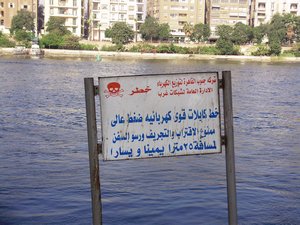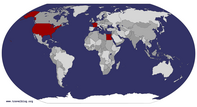Advertisement

 Sign along the Nile
Sign along the Nile
I don't know what it says, but I understand the skull and crossbones. You got it, Jolly Roger. I will stay away. The island in the back in Zamalek. 15 May 2010
1948 (GMT +3)
Giza, Egypt
I got an itch this morning to actually go out and see something - to play tourist for the day. After two weeks of being in country, I’ve finally come to a place where I’m comfortable enough to venture out. Where should I go? Alexandria? Not yet, let’s keep it in town for now. The pyramids? Not on your life. No, today I decided to go visit Coptic Cairo. And I must say it was definitely worth it.
I left early, at about 0800, to avoid the heat of the afternoon sun. My forecast called for a high of 102 F (39 C, for the rest of you), and I really didn’t want to be out too long in that. Since I had all day, and I set out early enough, I decided to go ahead and try walking. Most of the time I prefer to walk, as you get a chance to see more, as well as get some exercise. I haven’t been running since I’ve been here, as Cairo is not exactly a runner-friendly city, and I’m not interested in joining a gym here. So I set out on
my now familiar route, crossed Zamalek, and hooked up with
Corniche el-Nil, which runs along the Nile on the Cairo side of the river. I turned south, and walked past the southern end of Zamalek, then, to the end of the next island, known as
el-Manial. For those of you following along on your maps, follow
Corniche el-Nil to the southern-most end of el-Manial, go east a few inches, and that is Coptic Cairo. There is a metro stop right there, called Mar Girgis (Named after St. George, but I’ll come to that). It took me about two and a half hours to walk from Mohandeseen, and I would not recommend this for the feint of heart. Be smarter than me, and just take the metro. The station is very conveniently located right across the street from the Coptic Museum. Walking, I had a bit of a harder time finding my way to just the right spot, but when in doubt, follow the tour busses.
In any event, the Coptic tradition in Egypt is immensely interesting, and is worth discussing in some more detail. Finally, we have some history!
It seems obvious enough that Egypt is a predominately
Islamic country, but it also has a very significant Christian minority. Some estimates put the current Coptic population as high as 15%! (MISSING)It is also a very long tradition. In fact, Egypt claims a connection to the Holy Family going back to the very beginning.
You may recall the New Testament book of Matthew, which tells the story of the birth of Jesus, probably in 4 BC. According to Matthew, the
magi - who were sent by Herod the Great to find the baby - were warned by an angel not to return to Herod as he feared the birth of one who might someday challenge his authority, and sought to do away with the child. (Herod’s story in itself is eminently fascinating, but I don’t want to get off on too much of a tangent. It is worth mentioning, though, that Herod was only half-Jewish, and thus not really eligible to be king at all, but he was an acquaintance of the Roman Emperor Caesar Augustus. As most of us know, in many cases it’s not what you know, it’s who you know, and the same seems to have been true in Jewish-Roman Palestine during the turn of

 Inside the Hanging Church
Inside the Hanging Church
Inside the sanctuary. Notice the pulpit, which is several feet above the ground, in the center, front. the age.)
After the
magi departed, Herod issued an order for the murder of all boys under the age of two that had been born in Bethlehem. According to Matthew, “an angel of the Lord appeareth to Joseph in a dream, saying, Arise and take the young child and his mother, and flee into Egypt, and be thou there until I tell thee: for Herod will seek the young child to destroy him” (Matt. 2:13). As another quick side note, there is a debate among contemporary historians concerning Herod’s campaign against young boys in Bethlehem. Some believe that it didn’t actually occur, as Matthew is the only source we have for this. It is not mentioned in any of the other Gospels, though it is referenced a few times later in the New Testament, I believe in some of Paul's letters. Even the 1st Century Jewish-Roman historian Titus Flavius Josephus does not mention it in any of his works. One would think that something as big as the mass slaughter of young males would have been recorded in some other source.
Whatever the case, I’m getting way off track. The point here is that the Copts feel a

 Mosaic at Hanging Church
Mosaic at Hanging Church
In the courtyard leading up to the steps of the church. This picture shows the Holy Family in their journey to Egypt. very close connection to the Holy Family, and there is even a church in Coptic Cairo - the Church of St Sergius and St Bacchus - built over a cave where tradition holds that Joseph, Mary, and Jesus took shelter at some point during their stay in Egypt.
After the crucifixion, the Twelve Disciples split up and were sent into the world to spread the word. Most of us are familiar with Paul - not one of the original twelve, but a later disciple - who focused his attention on northern Palestine, Asia Minor, Greece, and eventually Rome. But one of the original disciples, Mark, made his way to Egypt, specifically Alexandria, where the Copts mark the beginning of their church. Later, St Mark (also known as St Mark the Evangelist) became the first martyr of the Coptic Church.
So, Egypt claims a very long and very close connection to Christianity going all the way back to the 1st Century AD.
Now, what to see in Coptic Cairo. First, check out the Hanging Church. This church is probably the most beautifully-ordained church in the district. The church, in various forms, dates back to the 4th Century, and

 Another Mosaic
Another Mosaic
Immediately to the left of the other mosaic, this one depicts the angel who appeared to Joseph in a dream and instructed him to flee to Egypt.has been rebuilt more than once since then. It gets its name from the fact that it was built over the water gate in the old Roman fortress of Babylon. (Not to be confused with the other Babylon, located in modern day Iraq.)
There are a great many tourists in this area, and as I sat in a pew in the Hanging Church, I was able to catch some of the lecture given by a tour guide about the church and Coptic doctrine in general. For example, Copts fast for about 200 days a year, where they do not eat during the day. When they do eat, it must be what we would consider vegan cuisine - no animal products of any kind. (Some believe that this is where the famous Egyptian dish
koshary came from.) Unlike Catholicism, Coptic priests must be married. In the sanctuary, one notices that there is the pulpit, plus three altars. According to this particular guide, this is because multiple masses cannot be taken at the same altar on the same day.
After the Hanging Church, I moved on to the Coptic Museum. This is a very nice facility, originally built in 1947,

 Church of St George
Church of St George
A Greek Orthodox Church. and contains some very early Coptic textiles, tapestries, stone work, and other artifacts. Tickets are 50 EGP, and you must check your camera at the door. I was a little annoyed at first, but when I started to see textiles from the 2nd and 3rd Centuries, I realized that they probably wouldn’t hold up to well to the flash of every idiot tourist that walks by. After all, nobody really pays attention to the signs that ask for no flash photography. There is a large range of artifacts, but the most interesting part to me was a collection of early images of various Biblical scenes and important figures in Coptic/Christian history. The dates of these images ranged from the 3rd Century to the 17th and 18th Centuries. The museum took me about an hour and a half to get through, and I confess that I sped through some of the less interesting parts, such as pottery fragments.
After the museum, I made my way up the steps to the Greek Orthodox Church of St George. According to my guidebook, St George (also known as the aforementioned Mar Giris) was a Roman legionnaire who was martyred after defying an edict

 Alleyway
Alleyway
Leading to the Church of St Sergius and St Bacchus, as well as the Church of St Barbara. Along the way are several stalls selling various items such as illuminated manuscript and prayer beads. There is also a full gift shop just ahead on the right. from the Emperor Diocletian in the 3rd Century, which outlawed the worship of Christ. The church is easily identifiable by its large dome structure, which was actually built in the early 20th Century, although a church dedicated to St George has been located at that spot since at least the 900s AD. Inside the church, pious visitors can reenact the persecution of St George by wrapping themselves in chains. It’s not exactly the sort of self-flagellation that one encounters during the Shi’a commemoration of the
Ashura Massacre, but it holds a very symbolic meaning for many.
I found my way to the Church of St Sergius and St Bacchus, where tradition holds that, under the church, there is a cave in which the Holy Family took shelter. Allegedly there is a way to get down into that crypt, but I was unable to find it.
There are several other sites in Coptic Cairo that are worth viewing - a working Coptic convent, the Church of St Barbara (who was martyred by her father in the 3rd Century after converting to Christianity), as well as a Jewish synagogue - but by this time, six hours after leaving my apartment, I was starting to succumb to hunger, thirst, and fatigue. It was also the hottest part of the day, and there was no smog today to block the sun. Of course, I didn't think to put on sun block that morning - did I mention that I went to college? So, I decided to call it a day.
No worries though, I plan to visit this area again once or twice over the next few months. They can keep the
Khan al-Khalili.
-MG
Advertisement
Tot: 0.132s; Tpl: 0.015s; cc: 9; qc: 49; dbt: 0.0512s; 1; m:domysql w:travelblog (10.17.0.13); sld: 1;
; mem: 1.2mb










Jess
non-member comment
Keep it up!
I'm really enjoying reading about your adventures....it makes me want to come visit....and that's something I never thought I'd say about the Middle East. Hope you're well! Love, Jess